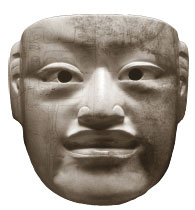

In the fifteenth century, While bronze and ironware had not yet been made in the Americas, which came to be known as the “New World,” sophisticated and accurate calendars and astronomy had already been developed there. These systems brought together the inner workings of nature, life, death, and rebirth. The current exhibition examines the pursuit to harmonize with nature over a period of more than three thousand years in Meso and South America. It also explores the spiritual world of the ancient Americas through over one hundred works that transmit the essence of their civilization.


Mirrors in Mesoamerica were made of several minerals including iron pyrite. Since the gods were believed to have shining golden bodies, the reflective surfaces of mirrors were associated with them. Mirrors represented the portal to the world of the gods and ancestors.



In ancient American myth, when the gods and ancestors passed through this world, they left behind masks and ornaments. Such masks were worn to communicate with the world of the gods and ancestors as well as for divination, healing, and praying for rain and bountiful harvests.




Various banquets and festivals were held when the ancestors were worshipped in the ancient Americas. Carved out of a single piece of rock in the shape of a gourd, this vessel was hollowed out on the inside and given a lid. The seeds of maize and squash appear to have been placed inside and offered to the ancestors. The gourd symbolized fertility and regeneration.
People in the ancient Americas, in general, lived to be about thirty-three. In such societies, the elders were greatly revered. Although this mask appears somewhat humorous, it is thought to be a portrait of a respected elder.




Engraved on this tripod vessel is a scene of the paradise of the sun god, where the blessed live after death. It was thought that the deceased would use such vessels at feasts in the afterlife. The incised inscriptions on this vessel reveal that it was used to serve a special chocolate drink.

In Mesoamerica, through its association with growth, regeneration, and maize (corn), the green hue of jade symbolized the central axis of the world that passed through the heavens, earth, and the underworlds. Jade was the most valued material, worth more than gold or silver. However, their ancient jade consists of various green minerals such as serpentine.